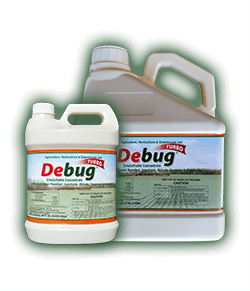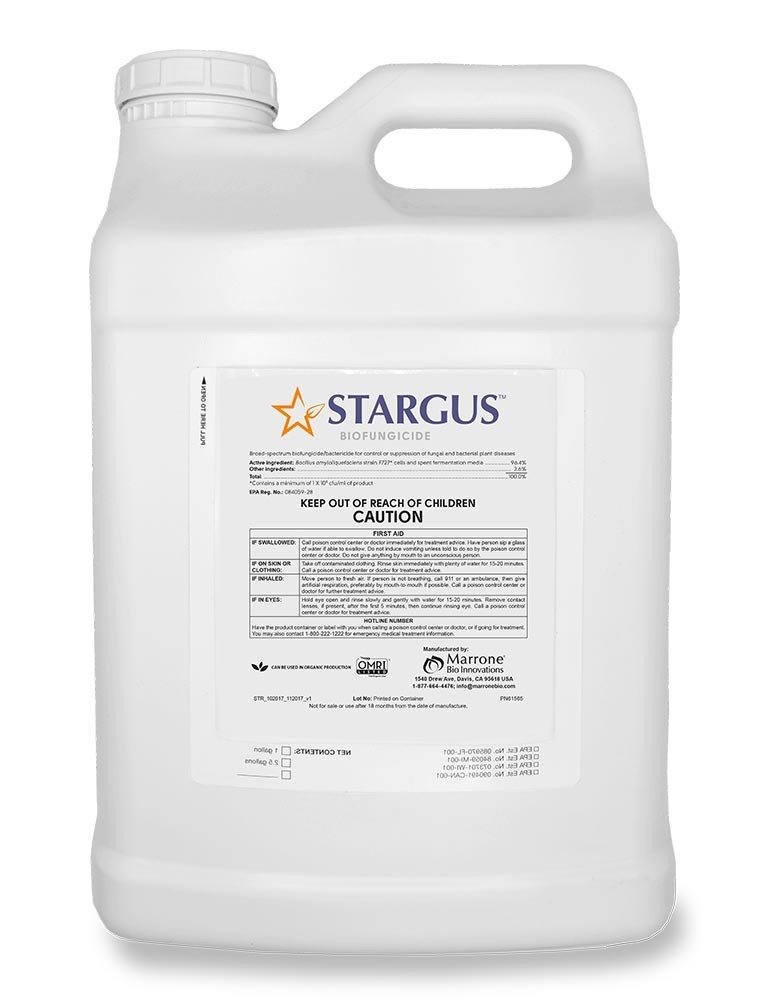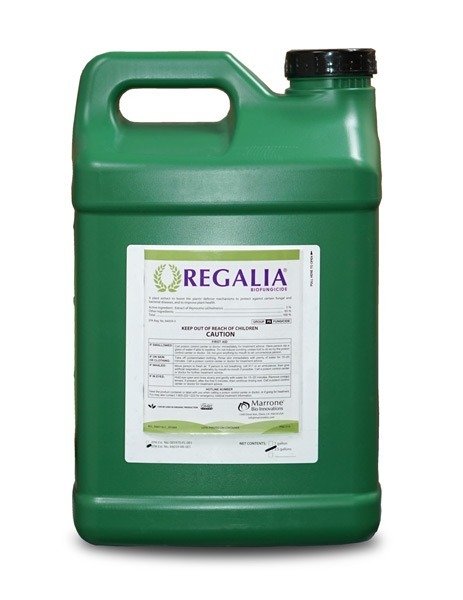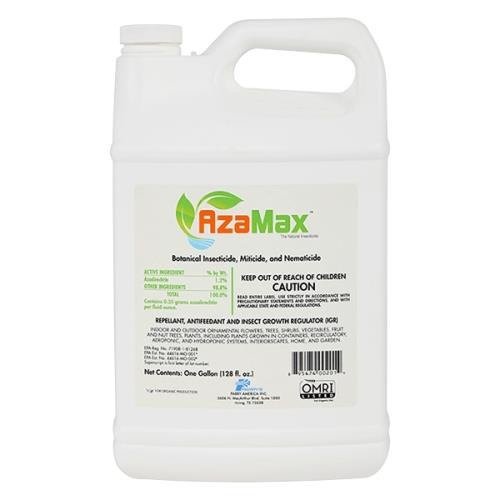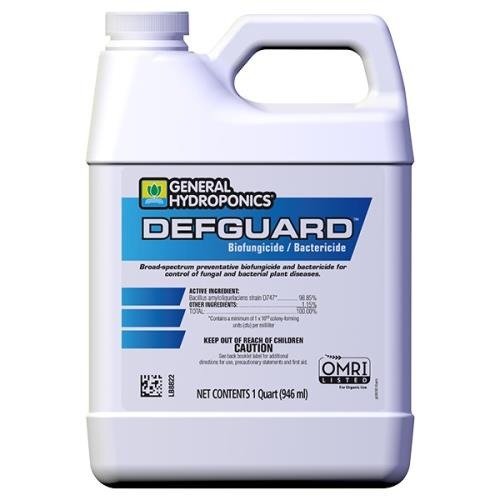What Pesticides and Fertilizers to use?
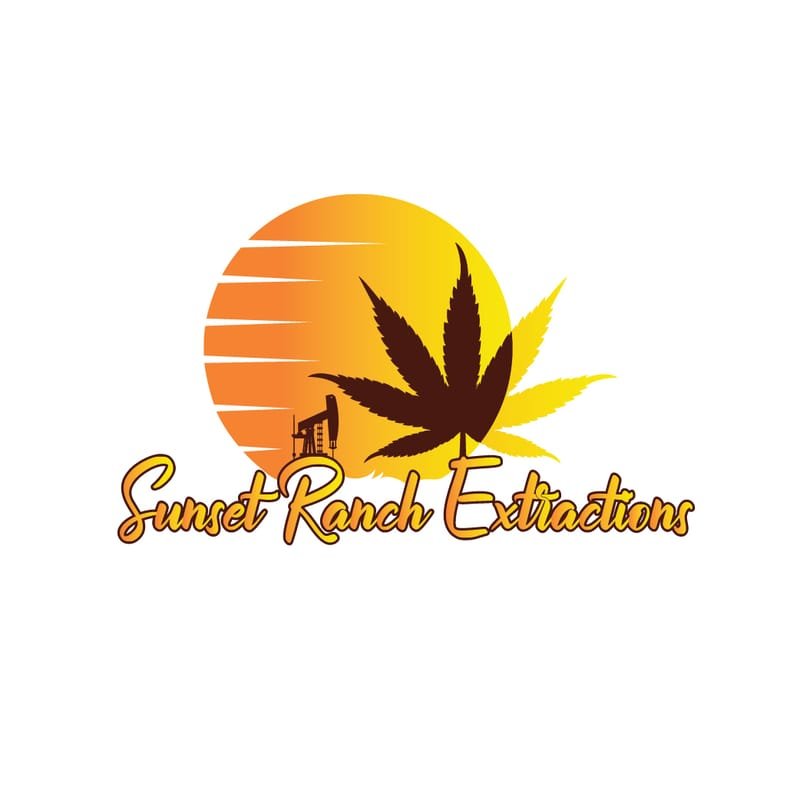
To get help with soil testing, and finding the best OMRI fertilizers and Pesticides, contact
Joe Tidwell @
e-mail: frontierplantsciences@gmail.com
Pesticides
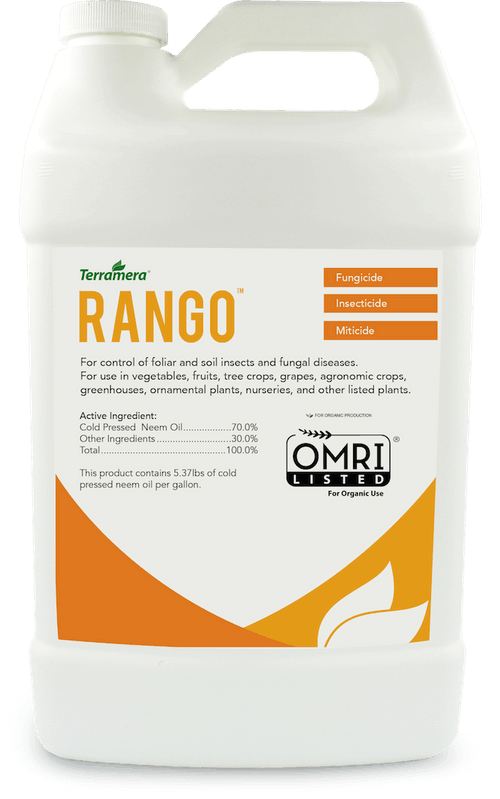
https://www.terrameraagriculture.com
One Product, Triple Control: Insecticide, Fungicide, Miticide
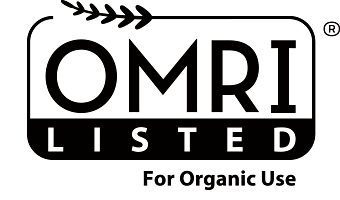
Description
RANGO™ is a highly efficacious biopesticide providing broad-range control of insects, mites and diseases
RANGO™ is OMRI listed for organic use
Features & Benefits
Better Handling: Lower freezing point (32-34 °F)
Superior Stability: Stays in suspension for more than 24 hours
Improved Performance: Better application coverage resulting in enhanced efficacy in the field
Can be used up to day of harvest: 4-hour REI and 0-day PHI
Superior Efficacy
Field trials have proven RANGO™ is a superior biopesticide allowing growers to farm as clean and natural as possible without sacrificing performance.
http://www.agrologistic.com/order.php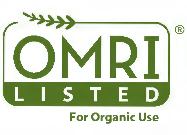
Quadruple action: Insecticide, Fungicide, Miticide, NematicideControls insects at egg, larva, pupa and adult stages
High concentration of active ingredients: 66.5%
Several active ingredients in a single product; Azadirachtin, tri-terpenoids & neem oil
Broad spectrum control on a wide variety of crops and pests
Low REI and PHI
Safe with beneficials
https://marronebio.com/products/stargus/
Control diseases longer with extended action. Provides broad spectrum disease control on challenging diseases such as downy mildew, Botrytis, Fusarium and more. Re-apply 2-4 times at 7-10 day intervals for extended efficacy throughout the season. Multiple modes of action make it a great resistance management tool.
Product Features:
MRL-exempt: No residue to worry about
Flexible labor scheduling: 0-Day PHI and 4 hour REI
Easy to tank mix
Minimal PPE
APPLICATION: Foliar (Aerial or Ground), Chemigation, Soil Treatment, Backpack/Hand Sprayer
ACTIVE INGREDIENT: Bacillus amyloliquefaciens F727
https://marronebio.com/products/regalia/
Regalia, a staple in IPM programs, is used preventatively for powdery mildew, blight, Anthracnose and other bacterial diseases.
Regalia Biofungicide delivers better yield and improved harvest quality. It’s ISR and SAR modes of action increase crop performance by stimulating a plant’s innate ability to fight diseases. This fungicide offers preventative activity and early control of yield-robbing diseases that result in increased marketable yield and top profit on every acre.
APPLICATION: Foliar (Aerial or Ground), Chemigation, Soil Treatment, Backpack/Hand Sprayer
ACTIVE INGREDIENT: Reynoutria sachalinensis
https://www.hawthornegc.com/shop/product/gh-azamax?categoryId=pest-and-disease-control
AzaMax™ is a natural product with a broad spectrum of pest control. It contains Azadirachtin A & B as active ingredients and more than 100 limonoids. AzaMax™ does not use hard chemical solvents and fully uses food-grade formulation ingredients. It is an antifeedant and insect growth regulator that controls pests through starvation and growth disruption. Effectively controls spider mites, thrips, fungus gnats, aphids, whiteflies, leaf miners, worms, beetles, leafhoppers, scales, mealy bugs, nematodes and other soil-borne pests. Mix a tablespoon per gallon.
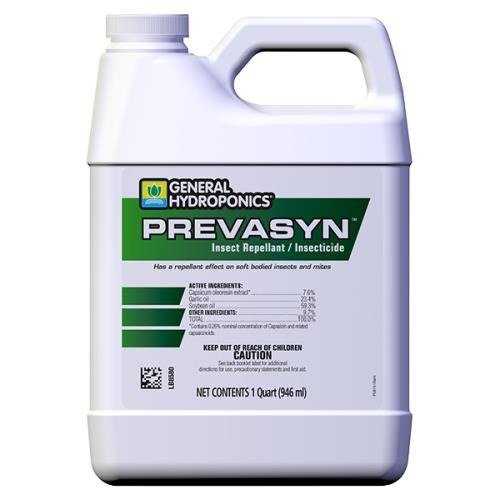
https://www.hawthornegc.com/shop/product/general-hydroponics-prevasyn-insect-repellant-insecticide?categoryId=pest-and-disease-control
General Hydroponics® Prevasyn™ Insect Repellant/Insecticide is an insect repellant that makes life miserable for bugs. It features concentrated plant extracts and capsicum oleoresin (pepper extract). The latter ingredient is the key—soft-bodied insects and mites can't stand its irritant properties. When applied regularly, General Hydroponics® Prevasyn™ Insect Repellant/Insecticide keeps bugs from eating or laying eggs on leaves. General Hydroponics® Prevasyn™ Insect Repellant/Insecticide is one of the few insect repellants on the market that has both concentrated plant extracts and capsicum oleoresin. Make it part of your strategy for managing bug problems.
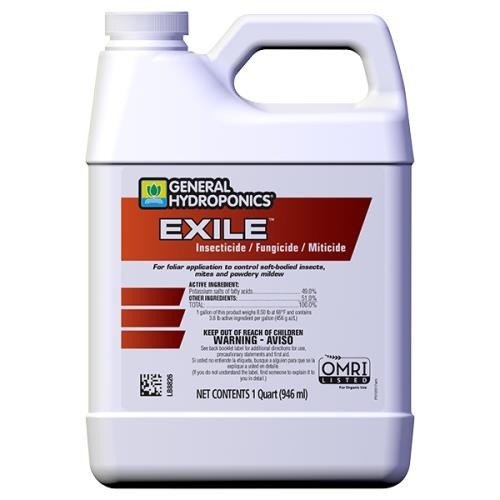
https://www.hawthornegc.com/shop/product/general-hydroponics-exile-insecticide-fungicide-miticide?categoryId=pest-and-disease-control
General Hydroponics® Exile™ Insecticide/Fungicide/Miticide is OMRI listed for use in organic gardening and an EPA-registered fungicide. That means one product gives you control of listed pests and diseases (e.g. soft-bodied pests and powdery mildew) in vegetable gardens, landscapes and greenhouses. The formulation is based on potassium salts of naturally derived fatty acids. General Hydroponics® Exile™ Insecticide/Fungicide/Miticide provides control of mites, aphids and whiteflies. Once you see a bug or two—or after they've already become a bigger problem—you can apply this product to control or suppress their population. It can be used right up to harvest on vegetables, grapes and other small fruits, tobacco, shrubs, foliage and flowering plants.
https://www.hawthornegc.com/shop/product/general-hydroponics-defguard-biofungicide-bactericide?categoryId=pest-and-disease-control
General Hydroponics® Defguard™ Biofungicide/Bactericide is an OMRI-listed biofungicide and bactericide for use in organic gardening that's effective against a variety of pathogens, particularly botrytis (which causes botrytis blight, or gray mold) and powdery mildew. It also controls anthracnose; bacterial leaf blights, spots and specks; black mold; black spot (on roses); brown spot; fruit rot; and leaf spots. If you need a biofungicide/bactericide that prevents bacterial and fungal diseases from even establishing themselves on leaves, look no further than General Hydroponics® Defguard™ Biofungicide/Bactericide.
Below, I have added a list of Synthetic Substances that are allowed for use in organic crop production found at eCFR.gov.
In accordance with restrictions specified in this section, the following synthetic substances may be used in organic crop production: Provided, That, use of such substances do not contribute to contamination of crops, soil, or water. Substances allowed by this section, except disinfectants and sanitizers in paragraph (a) and those substances in paragraphs (c), (j), (k), and (l) of this section, may only be used when the provisions set forth in §205.206(a) through (d) prove insufficient to prevent or control the target pest.
As algicide, disinfectants, and sanitizer, including irrigation system cleaning systems.
Alcohols.
- Ethanol.
- Isopropanol.
Chlorine materials—For pre-harvest use, residual chlorine levels in the water in direct crop contact or as water from cleaning irrigation systems applied to soil must not exceed the maximum residual disinfectant limit under the Safe Drinking Water Act, except that chlorine products may be used in edible sprout production according to EPA label directions.
- Calcium hypochlorite.
- Chlorine dioxide.
- Hypochlorous acid—generated from electrolyzed water.
- Sodium hypochlorite.
Copper sulfate—for use as an algicide in aquatic rice systems, is limited to one application per field during any 24-month period. Application rates are limited to those which do not increase baseline soil test values for copper over a timeframe agreed upon by the producer and accredited certifying agent.
Hydrogen peroxide.
Ozone gas—for use as an irrigation system cleaner only.
Peracetic acid—for use in disinfecting equipment, seed, and asexually propagated planting material. Also permitted in hydrogen peroxide formulations as allowed - no more than 6% as indicated on the pesticide product label.
Soap-based algicide/demossers.
Sodium carbonate peroxyhydrate (CAS #-15630-89-4)—Federal law restricts the use of this substance in food crop production to approved food uses identified on the product label.
As herbicides, weed barriers, as applicable.
Herbicides, soap-based—for use in farmstead maintenance (roadways, ditches, right of ways, building perimeters) and ornamental crops.
Mulches.
- Newspaper or other recycled paper, without glossy or colored inks.
- Plastic mulch and covers (petroleum-based other than polyvinyl chloride (PVC)).
- Biodegradable biobased mulch film as defined in §205.2. Must be produced without organisms or feedstock derived from excluded methods.
As compost feedstocks—Newspapers or other recycled paper, without glossy or colored inks.
As animal repellents—Soaps, ammonium—for use as a large animal repellant only, no contact with soil or edible portion of crop.
As insecticides (including acaricides or mite control).
Ammonium carbonate—for use as bait in insect traps only, no direct contact with crop or soil.
Aqueous potassium silicate (CAS #-1312-76-1)—the silica, used in the manufacture of potassium silicate, must be sourced from naturally occurring sand.
Boric acid—structural pest control, no direct contact with organic food or crops.
Copper sulfate—for use as tadpole shrimp control in aquatic rice production, is limited to one application per field during any 24-month period. Application rates are limited to levels which do not increase baseline soil test values for copper over a timeframe agreed upon by the producer and accredited certifying agent.
Elemental sulfur.
Lime sulfur—including calcium polysulfide.
Oils, horticultural—narrow range oils as dormant, suffocating, and summer oils.
Soaps, insecticidal.
Sticky traps/barriers.
Sucrose octanoate esters (CAS #s—42922-74-7; 58064-47-4)—in accordance with approved labeling.
As insect management. Pheromones.
As rodenticides. Vitamin D3.
As slug or snail bait.
- Ferric phosphate (CAS # 10045-86-0).
- Elemental sulfur.
As plant disease control.
Aqueous potassium silicate (CAS #-1312-76-1)—the silica, used in the manufacture of potassium silicate, must be sourced from naturally occurring sand.
Coppers, fixed—copper hydroxide, copper oxide, copper oxychloride, includes products exempted from EPA tolerance, Provided, That, copper-based materials must be used in a manner that minimizes accumulation in the soil and shall not be used as herbicides.
Copper sulfate—Substance must be used in a manner that minimizes accumulation of copper in the soil.
Hydrated lime.
Hydrogen peroxide.
Lime sulfur.
Oils, horticultural, narrow range oils as dormant, suffocating, and summer oils.
Peracetic acid—for use to control fire blight bacteria. Also permitted in hydrogen peroxide formulations as allowed in §205.601(i) at concentration of no more than 6% as indicated on the pesticide product label.
Potassium bicarbonate.
Elemental sulfur.
Polyoxin D zinc salt.
- As plant or soil amendments.
Aquatic plant extracts (other than hydrolyzed)—Extraction process is limited to the use of potassium hydroxide or sodium hydroxide; solvent amount used is limited to that amount necessary for extraction.
Elemental sulfur.
Humic acids—naturally occurring deposits, water and alkali extracts only.
Lignin sulfonate—chelating agent, dust suppressant.
Magnesium oxide (CAS # 1309-48-4)—for use only to control the viscosity of a clay suspension agent for humates.
Magnesium sulfate—allowed with a documented soil deficiency.
Micronutrients—not to be used as a defoliant, herbicide, or desiccant. Those made from nitrates or chlorides are not allowed. Micronutrient deficiency must be documented by soil or tissue testing or other documented and verifiable method as approved by the certifying agent.
Soluble boron products.
- Sulfates, carbonates, oxides, or silicates of zinc, copper, iron, manganese, molybdenum, selenium, and cobalt.
Liquid fish products—can be pH adjusted with sulfuric, citric or phosphoric acid. The amount of acid used shall not exceed the minimum needed to lower the pH to 3.5.
Vitamins, B1, C, and E.
Squid byproducts—from food waste processing only. Can be pH adjusted with sulfuric, citric, or phosphoric acid. The amount of acid used shall not exceed the minimum needed to lower the pH to 3.5.
Sulfurous acid (CAS # 7782-99-2) for on-farm generation of substance utilizing 99% purity elemental sulfur per paragraph (j)(2) of this section.
- As plant growth regulators. Ethylene gas—for regulation of pineapple flowering.
- As floating agents in postharvest handling. Sodium silicate—for tree fruit and fiber processing.
- As synthetic inert ingredients as classified by the Environmental Protection Agency (EPA), for use with nonsynthetic substances or synthetic substances listed in this section and used as an active pesticide ingredient in accordance with any limitations on the use of such substances.
EPA List 4—Inerts of Minimal Concern.
EPA List 3—Inerts of unknown toxicity—for use only in passive pheromone dispensers.
- Seed preparations. Hydrogen chloride (CAS # 7647-01-0)—for delinting cotton seed for planting.
- As production aids. Microcrystalline cheesewax (CAS #'s 64742-42-3, 8009-03-08, and 8002-74-2)-for use in log grown mushroom production. Must be made without either ethylene-propylene co-polymer or synthetic colors.
Nonagricultural (nonorganic) substances that are allowed as ingredients in or on processed products labeled as “organic” or “made with organic (specified ingredients or food group(s)).”
The following nonagricultural substances may be used as ingredients in or on processed products labeled as “organic” or “made with organic (specified ingredients or food group(s))” only in accordance with any restrictions specified in this section.
Nonsynthetics allowed:
Acids (Citric—produced by microbial fermentation of carbohydrate substances; and Lactic).
Agar-agar.
Animal enzymes—(Rennet—animals derived; Catalase—bovine liver; Animal lipase; Pancreatin; Pepsin; and Trypsin).
Attapulgite—as a processing aid in the handling of plant and animal oils.
Bentonite.
Calcium carbonate.
Calcium chloride.
Calcium sulfate—mined.
Carrageenan.
Dairy cultures.
Diatomaceous earth—food filtering aid only.
Enzymes—must be derived from edible, nontoxic plants, nonpathogenic fungi, or nonpathogenic bacteria.
Flavors—nonsynthetic flavors may be used when organic flavors are not commercially available. All flavors must be derived from organic or nonsynthetic sources only and must not be produced using synthetic solvents and carrier systems or any artificial preservative.
Gellan gum (CAS # 71010-52-1)—high-acyl form only.
Glucono delta-lactone—production by the oxidation of D-glucose with bromine water is prohibited.
Kaolin.
L-Malic acid (CAS # 97-67-6).
Magnesium chloride.
Magnesium sulfate, nonsynthetic sources only.
Microorganisms—any food grade bacteria, fungi, and other microorganism.
Nitrogen—oil-free grades.
Oxygen—oil-free grades.
Perlite—for use only as a filter aid in food processing.
Potassium chloride.
Potassium iodide.
Sodium bicarbonate.
Sodium carbonate.
Tartaric acid—made from grape wine.
Waxes—nonsynthetic (Wood resin).
Yeast—When used as food or a fermentation agent in products labeled as “organic,” yeast must be organic if its end use is for human consumption; nonorganic yeast may be used when organic yeast is not commercially available. Growth on petrochemical substrate and sulfite waste liquor is prohibited. For smoked yeast, nonsynthetic smoke flavoring process must be documented.
Synthetics allowed:
Acidified sodium chlorite—Secondary direct antimicrobial food treatment and indirect food contact surface sanitizing. Acidified with citric acid only.
Activated charcoal (CAS #s 7440-44-0; 64365-11-3)—only from vegetative sources; for use only as a filtering aid.
Alginates.
Alginic acid (CAS #9005-32-7)
Ammonium bicarbonate—for use only as a leavening agent.
Ammonium carbonate—for use only as a leavening agent.
Ascorbic acid.
Calcium citrate.
Calcium hydroxide.
Calcium phosphates (monobasic, dibasic, and tribasic).
Carbon dioxide.
Cellulose (CAS #9004-34-6)—for use in regenerative casings, powdered cellulose as an anti-caking agent (non-chlorine bleached) and filtering aid. Microcrystalline cellulose is prohibited.
Chlorine materials—disinfecting and sanitizing food contact surfaces, equipment and facilities may be used up to maximum labeled rates. Chlorine materials in water used in direct crop or food contact are permitted at levels approved by the FDA or EPA for such purpose, provided the use is followed by a rinse with potable water at or below the maximum residual disinfectant limit for the chlorine material under the Safe Drinking Water Act. Chlorine in water used as an ingredient in organic food handling must not exceed the maximum residual disinfectant limit for the chlorine material under the Safe Drinking Water Act.
- Calcium hypochlorite.
- Chlorine dioxide.
- Hypochlorous acid—generated from electrolyzed water.
- Sodium hypochlorite.
Ethylene—allowed for postharvest ripening of tropical fruit and degreening of citrus.
Ferrous sulfate—for iron enrichment or fortification of foods when required by regulation or recommended (independent organization).
Glycerides (mono and di)—for use only in drum drying of food.
Hydrogen peroxide.
Magnesium stearate—for use only in agricultural products labeled “made with organic (specified ingredients or food group(s)),” prohibited in agricultural products labeled “organic”.
Nutrient vitamins and minerals, in accordance with 21 CFR 104.20, Nutritional Quality Guidelines For Foods.
Ozone.
Peracetic acid/Peroxyacetic acid (CAS # 79-21-0)—for use in wash and/or rinse water according to FDA limitations. For use as a sanitizer on food contact surfaces.
Phosphoric acid—cleaning of food-contact surfaces and equipment only.
Potassium carbonate.
Potassium citrate.
Potassium hydroxide—prohibited for use in lye peeling of fruits and vegetables except when used for peeling peaches.
Potassium lactate—for use as an antimicrobial agent and pH regulator only.
Potassium phosphate—for use only in agricultural products labeled “made with organic (specific ingredients or food group(s)),” prohibited in agricultural products labeled “organic”.
Silicon dioxide—Permitted as a defoamer. Allowed for other uses when organic rice hulls are not commercially available.
Sodium acid pyrophosphate (CAS # 7758-16-9)—for use only as a leavening agent.
Sodium citrate.
Sodium hydroxide—prohibited for use in lye peeling of fruits and vegetables.
Sodium lactate—for use as an antimicrobial agent and pH regulator only.
Sodium phosphates—for use only in dairy foods.
Sulfur dioxide—for use only in wine labeled “made with organic grapes,” Provided, That, total sulfite concentration does not exceed 100 ppm.
Tocopherols—derived from vegetable oil when rosemary extracts are not a suitable alternative.
Xanthan gum.
Nonorganically produced agricultural products that are allowed as ingredients in or on processed products labeled as “organic.”
Only the following nonorganically produced agricultural products may be used as ingredients in or on processed products labeled as “organic,” only in accordance with any restrictions specified in this section, and only when the product is not commercially available in organic form.
Carnauba wax
Casings, from processed intestines.
Celery powder.
Colors derived from agricultural products—Must not be produced using synthetic solvents and carrier systems or any artificial preservative.
- Beet juice extract color—derived from Beta vulgaris L., except must not be produced from sugarbeets.
- Beta-carotene extract color—derived from carrots (Daucus carota L.) or algae (Dunaliella salina).
- Black currant juice color—derived from Ribes nigrum L.
- Black/purple carrot juice color—derived from Daucus carota L.
- Blueberry juice color—derived from blueberries (Vaccinium spp.).
- Carrot juice color—derived from Daucus carota L.
- Cherry juice color—derived from Prunus avium (L.) L. or Prunus cerasus L.
- Chokeberry, aronia juice color—derived from Aronia arbutifolia (L.) Pers. or Aronia melanocarpa (Michx.) Elliott.
- Elderberry juice color—derived from Sambucus nigra L.
- Grape juice color—derived from Vitis vinifera L.
- Grape skin extract color—derived from Vitis vinifera L.
- Paprika color—derived from dried powder or vegetable oil extract of Capsicum annuum L.
- Pumpkin juice color—derived from Cucurbita pepo L. or Cucurbita maxima Duchesne.
- Purple sweet potato juice color—derived from Ipomoea batatas L. or Solanum tuberosum L.
- Red cabbage extract color—derived from Brassica oleracea L.
- Red radish extract color—derived from Raphanus sativus L.
- Saffron extract color—derived from Crocus sativus L.
- Turmeric extract color—derived from Curcuma longa L.
Fish oil (Fatty acid CAS #'s: 10417-94-4, and 25167-62-8)—stabilized with organic ingredients or only with ingredients on the National List, §§205.605 and 205.606.
Fructooligosaccharides (CAS # 308066-66-2).
Gelatin (CAS # 9000-70-8).
Glycerin (CAS # 56-81-5)—produced from agricultural source materials and processed using biological or mechanical/physical methods as described under §205.270(a).
Gums—water extracted only (Arabic; Guar; Locust bean; and Carob bean).
Inulin-oligofructose enriched (CAS # 9005-80-5).
Kelp—for use only as a thickener and dietary supplement.
Konjac flour (CAS # 37220-17-0).
Lecithin—de-oiled.
Orange pulp, dried.
Orange shellac-unbleached (CAS # 9000-59-3).
Pectin (non-amidated forms only).
Potassium acid tartrate.
Seaweed, Pacific kombu.
Starches.
Cornstarch (native).
Sweet potato starch—for bean thread production only.
Tragacanth gum (CAS #-9000-65-1).
Turkish bay leaves.
Wakame seaweed (Undaria pinnatifida).
Whey protein concentrate.
Non-Synthetic Substances that are NOT ALLOWED for use in organic crop production found at eCFR.gov.
The following nonsynthetic substances may not be used in organic crop production:
Ash from manure burning.
Arsenic.
Calcium chloride, brine process is natural and prohibited for use except as a foliar spray to treat a physiological disorder associated with calcium uptake.
Lead salts.
Potassium chloride—unless derived from a mined source and applied in a manner that minimizes chloride accumulation in the soil.
Rotenone (CAS # 83-79-4).
Sodium fluoaluminate (mined).
Sodium nitrate—unless use is restricted to no more than 20% of the crop's total nitrogen requirement; use in spirulina production is unrestricted until October 21, 2005.
Strychnine.
Tobacco dust (nicotine sulfate).
Amending the National List
Any person may petition the National Organic Standards Board for the purpose of having a substance evaluated by the Board for recommendation to the Secretary for inclusion on or deletion from the National List in accordance with the Act.
A person petitioning for amendment of the National List should request a copy of the petition procedures from the USDA at the address in §205.607(c).
A petition to amend the National List must be submitted to: Program Manager, USDA-AMS-NOP, 1400 Independence Ave. SW., Room 2648 So. Bldg., Ag Stop 0268, Washington, DC 20250-0268.
